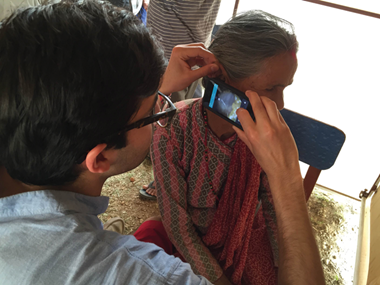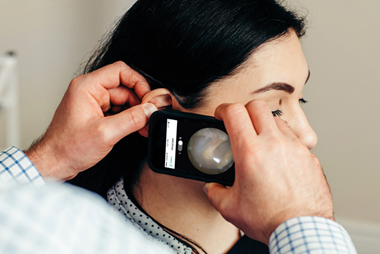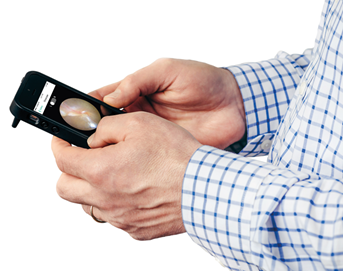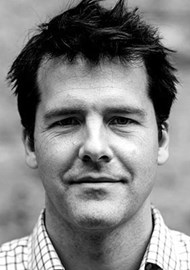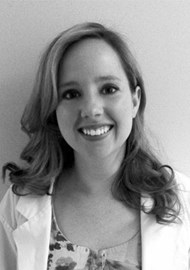In recent years, there has been a definite shift toward the acceptance and use of smartphone technology in the delivery of healthcare. Within the fields of ENT and audiology, there is considerable appeal in the portability, simplicity, affordability, and connectivity of smartphone-connected devices and apps. As a result, modern twists on our tools of the trade have started to enter the market (including the CellscopeOto and the Endoscope-i, which we have covered previously in Tech Reviews).
Cupris is a company that is hoping to modernise how healthcare is delivered through their software communication platform, which allows for remote consultations among other things, and various smartphone-enabled medical devices. Their first product to market is a smart otoscope (TYM Otoscope; www.cupris.com) that lets clinicians collect and securely store otoscopic images and video.
Carolyn Falls recently had the opportunity to speak with Dr Julian Hamann, a surgeon and NHS consultant, who is the Medical Director and Co-Founder behind Cupris. He gave the scoop on Cupris, including the details behind their uniquely humanitarian approach.
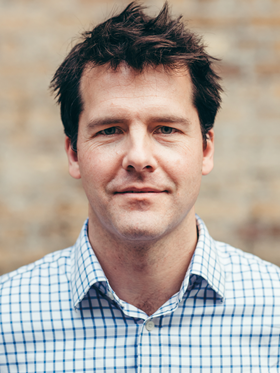
Dr Julian Hamann.
Welcome Dr Hamann! Can you tell me more about what inspired the development of the Cupris platform?
It’s been a work in progress for several years. It was principally based upon having 15 years of experience in the healthcare system and this observation that communication in healthcare can be dreadful, flawed, and ultimately a cause of error and unnecessary suffering. The other part was that healthcare delivery had become so antiquated and hadn’t changed significantly over the last 200 years. We wanted to look at improving communication to reduce errors and to make care more convenient for patients. That was the founding idea. Patients could be treated at home without having to come to hospital as often.
How did your team approach this challenge?
Our approach was to look at what constitutes medical communication and to figure out what parts could be digitised. Broadly speaking, you have the verbal part, where the team asks and answers questions. That becomes the software. Then you have the physical part – the exams and the investigations you do - that’s where the hardware comes in. When you can digitise both parts, remote examinations become possible.
“Healthcare delivery had become so antiquated and hadn’t changed significantly over the last 200 years.”
Can an app really mimic the verbal interaction between a healthcare professional and a patient?
In reality, much of what healthcare workers do is quite routine and formulaic. You end up asking the same questions, using the same increases in complexity along the way. Our team found that we could design questionnaires that captured the information that was needed so that either the problem could be managed remotely, or the number / length of visits was reduced. When you think of this in terms of time management, there’s the potential to streamline your process so less time is wasted from those routine, repetitive behaviours.
Let’s talk about putting those remote examinations into practice. From the outset, Cupris Health has demonstrated a commitment to making a social impact in the developing world. The Cupris TYM Otoscope has now been successfully tested in Nepal and Malawi, with an upcoming study also planned for Aboriginal populations in Australia. Why did you include that as part of your mandate?
From the outset, it was clear that we wanted to be a social enterprise with a strong humanitarian aspect to our work. There was also the recognition that remote care might be adopted more readily in emerging economies where there are greater resource constraints. In the areas we’ve worked in, generally about 70% of your healthcare resources are in urban areas, but 70% of the demand is in rural areas. It’s not uncommon for people to travel for a couple of days to get to clinics and hospitals. With increasingly good mobile coverage in these areas, it was a natural fit. Also, from a practical perspective, there’s a greater appetite in emerging economies for adopting new ways of doing things. There aren’t as many cultural constraints and the workflow is not as entrenched or rigid.
“There’s a greater appetite in emerging economies for adopting new ways of doing things. There aren’t as many cultural constraints and the workflow is not as entrenched or rigid.”
Where do you see this going in the future as the technology improves?
We are already gathering a powerful dataset of signs and symptoms, which is perfect for machine learning. We’ve been working with IBM on developing algorithms to assist with diagnosis and management of patients. This is all very much part of the future of healthcare and it’s all going to happen very quickly.
Do you think you are working yourself out of a job?
I do think that many people in skilled professions will be disrupted as technology improves. However, artificial intelligence (AI) is not good at the emotional side of human interactions – which are so important in healthcare – and I don’t see that changing for the foreseeable future. Also, there’s such a massive shortage of healthcare professionals globally that I see this shift as being a positive change overall.
Interviewed by Carolyn Falls.
For more information about Cupris Health and to purchase the TYM Otoscope, please visit
www.IFHNOS.NET/online-fellowship

